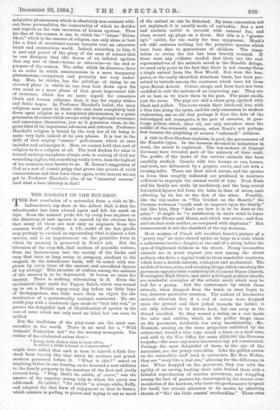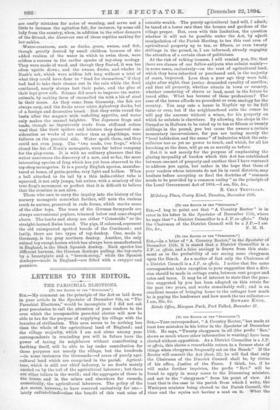THE ZOOLOGY OF THE TOY-SHOP.
'THE first conclusion of a naturalist from a visit to Mr. Labouchere's toy show at the Albert Hall is that the schoolmaster has been abroad again and left his mark on toys. Even the natural pride felt by every true inquirer on the discovery of new species is marred by the obvious fact that many of these are new only as migrants from the common world of reality. A 4 ft. model of the last giraffe may perhaps be excused as representing what is almost a lost species, and is an improvement on the primitive form in which its memory is preserved in Noah's ark. But the intrusion of the cray-fish, that medium of scientific culture, from the lecture-room into the society of the ducks and carp that have so long swum in company, obedient to the magnet, in the schoolroom basin, will be noted with sus- picion by every lover of the ancient and accredited figures of toy zoology. This invasion of realism among the animals of the nursery is to be deprecated. It leaves no room for inquiry. There is nothing stimulating in it Even the mechanical tiger made for Tippoo Sahib, which was wound up to eat a British sepoy every day before the little boys of Seringapatam, was little more than an object for the inculcation of a praiseworthy national sentiment. No one could play with a clockwork tiger made to "look like real," or pursue the delightful task of identification of species in the case of cows which not only need no label, but can even be milked
But the traditions of the play-room are the most con- servative in the world. There is no need for a "Wild Animals' Protection Act" for the nursery menagerie. The author of the celebrated axiom that- " Every little Briton that is born alive, Is either a little Liberal or Conservative," might have added that each is born to inherit a little live- stock farm exactly like that which its mothers and grand- mothers possessed before it. "What is this P" asked an Inquiring father in our hearing, as he detected a new addition to the family property in the sanctum of the first and justly revered baby. " Why, that's its rabbit, of course," was the answer of the superior young lady to whom the query was addressed. Rs rabbit "Its rabbit" is always white, fluffy, and adapted for that form of enjoyment so dear to babies, which consists in pulling to pieces and trying to eat as much
of the animal as can be detached. By some convention not yet explained, it is usually made of oat's-skin. But a new and realistic rabbit is covered with natural fur, and when wound up, plays on a drum. But this is a " grown- up's " rabbit, far too costly for true enjoyment. Noah's ark still contains nothing but the primitive species which have been dear to generations of children. The temp- tation to revise the list has been bravely resisted. If there were any evidence needed that these are the real representatives of the animals saved in the Noachic deluge, we need only point to the fact that there is not among them a single animal from the New World. Not even the kan- garoo, or the easily identified American bison, has been per-
mitted to intrude among the creatures which were let loose upon Mount Ararat. Colour, shape, and form have not been modified to suit the notions of an improving age. They are all as lean as we knew them in the past. The paint smells just the same. The pigs are still a china-grey, spotted with black and yellow. The cows retain their brick-red hue, with a blue line along the spine, and the only concession to modern exploration, one so old that perhaps it fixes the date of the stereotyped ark menagerie, is the pair of canaries, in gam- booge yellow, which, after all, are only intruders since the middle of the sixteenth century, when Noah's ark perhaps first became the plaything of serious "reformed." children.
A visit to Kew Gardens explains, in part, the permanence of the Noachic types. In the museum devoted to industries in
wood, the secret is explained. The toy-makers of Central Germany have revealed part of the mystery of their craft. The profile of the backs of the various animals has been carefully studied. Camels with two humps or one, horses, and cows, are delineated by a graphic curve, and cut with a turning-lathe. These are then sliced across, and the species in form thus roughly indicated are produced in numbers sufficient to re-people the animal world of toys. Even Noah and his family are made by machinery, and the long-coated flat-hatted figures fall from the lathe in lines of seven, each adhering by its hat to the feet of the other. Possibly, like the toy-maker in "The Cricket on the Hearth," the German workmen "could wish to improve upon the family," but like him, they "don't see how it is to be done at the price." It might be "a satisfaction to one's mind to know which was Shems and Hams, and which was wives ; and flies ain't on that scale neither, as compared with elephants." But measurement is not the standard of the toy museum.
Most readers of Punch will recollect Leech's picture of a "pretty toy," an eight-clawed spider as large as a crab, which a cadaverous hawker dangles at the end of a string before the eyes of frightened children in the street. Penny locomotive animals are in great request just now among the street pedlars, who drive a capital trade in these wonderful creatures, which have a double interest, zoological and mechanical. The models of horses, mice, and creeping things, which run along the pavement opposite their vendors by St. Clement Danes Church, Kensington High Street, and other privileged pedlars' stands, are wonderful examples of the artistic merit which may be had for a penny. But the contrivance by which these animals, when dropped from the hand, at once begin to run, deserves particular mention. The makers of locomotive animals observed that if a reel of cotton were dropped upon the ground and then jerked towards the holder, it not only refused to be drawn back, but ran away as the thread unrolled. So they wound a string on a reel inside the mice and rabbits, which, as the pedlar drops them on the pavement, forthwith run away incontinently. Mr. Brennan, musing on the same properties exhibited by the cotton-reel, wound a wire rope round a drum on a steel case, and sold to the War Office for some vzo,000 the Brennan torpedo,—the most expensive locomotive toy yet constructed. Perhaps the most delightful of these, in the eye of the naturalist, are the penny crocodiles. Like the golden crown on the constable's staff used to intimidate Mr. Sam Weller, they are " wery like a real one," allowing for the difference in size. When dropped on the pavement, they run with the agility of an earwig, trailing their tails behind them with a faithful reproduction of saurian movement, and wriggling among the feet of passers-by, encouraged by the hoarse com- mendation of the hawkers, who leave the performance to speak for itself, but attract attention to its merits by admiring shouts of " Ho ! the little runnin' crockerdiles." These ones
are easily mistaken for notes of warning, and serve not a little to increase the agitation felt, for instance, by some ola lady from the country, when, in addition to the other dangers of the Strand, she discovers one of these reptiles making for her ankles.
Water-creatures, such as ducks, geese, swans, and flab, though greatly desired by small children because of the added realism of the water in which to swim them, were seldom a success in the earlier epochs of toy-shop zoology. They were made of wood, and though they floated, it was too often upside down ; and the swans, ducks, and whales in Noah's ark, which were seldom left long without a trial of what they could have done to "fend for themselves," if they had had to take their chance out in the rain while the flood continued, nearly always lost their paint, and the glue of their legs grew soft. Science did much to improve the water- animals, by making them of enamelled tin with a bit of steel in their noses. As they come from Germany, the fish are always carp, and the ducks never white Aylesbury ducks, but of a foreign and decorative breed. But they swim round the basin after the magnet with unfailing appetite, and water only makes the enamel brighter. The Japanese frogs and toads, though so ingeniously made from stiffened cotton wool that like their spiders and lobsters they deserved con- sideration as works of art rather than as playthings, were failures on the practical side. Water spoilt them, and they could not even jump. The "two toads, two frogs," which closed the list of Noah's menagerie, were far better company for the play-room. It is with no ordinary pleasure that the writer announces the discovery of a new, and so far, the most interesting species of frog which has yet been observed in the toy-shop menageries. It is a purely English species, manufac- tured at home, of gutta-percha, very light and hollow. When a ball attached to its tail by a thin india-rubber tube is squeezed, it not only jumps, but swims, with a mimicry of the true frog's movement so perfect that it is difficult to believe that the creature is not alive.
Those who care to carry the inquiry into the history of the nursery menagerie somewhat farther, will note the curious truth to nature, preserved in rude forms, which marks some of the older toys. The trees of the German farmyards are always conventional poplars, trimmed below and cone-shaped above. The lambs and sheep are either " Cotswolds " or the straight-horned Swiss breed. The pigs, if coloured, represent the old unimproved spotted breeds of the Continent ; and lastly, there are two types of toy-donkey. One, made in Germany, is the grey northern donkey. Another, the only animal toy except horses which has always been manufactured in England, is the black Spanish donkey. Each species has different harness, the German donkeys pulling the toy-carts by a breastplate and a "breech-strap," while the Spanish donkeys—made in England—are fitted with a crupper and panniers.


































 Previous page
Previous page